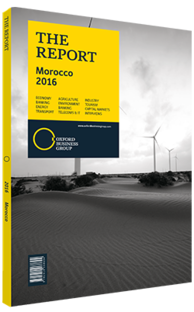Banking
Company Overview
Attijariwafa Bank is the leading bank in Morocco in terms of outstanding loans (25% as of December 2015), and number two in terms of deposits behind BCP. The group operates 3265 branches and started its geographical expansion outside Morocco in 2005. The bank now has branches in Tunisia (6% of consolidated net income) and nine French-speaking sub-Saharan countries (13% of consolidated net income). Attijariwafa Bank operates in all banking business segments including retail banking, consumer loans and mortgages and is also the majority shareholder (79%) of Wafa Assurance, Morocco’s leading insurance company.
By the end of 2015 the group improved consolidated deposits by 6.5%. Outstanding loans decreased slightly by 0.8%. Regarding the group’s profit and loss, net interest margin (NIM) increased by 3.4%. The net fees margin increased by 4.3% to Dh4bn (€366.8m). As expected, income from market activities dropped 24%, standing at Dh3.1bn (€284.2m). Thus, net banking income (NBI) dropped 2.3%, totalling Dh18.9bn (€1.7bn). The gross operating income decreased by 6.9% due to a higher cost-to-income ratio of 46.4%. As expected, the bank recorded a favourable development of its cost of risk, delivering a stronger-than-expected drop of 27% to Dh2.2bn (€201.7m), or 0.83% of gross outstanding loans. Net income group share (NIGS) stood at Dh4.5bn (€412.6m). The management announced a dividend of Dh11 (€1) per share (a dividend yield of 3.3%).
Outlook
We believe that the bank’s consolidated deposits should grow by 5.2% in 2016 and 5.7% in 2017. As far as loans are concerned, growth should remain weak at 2.7% in 2016 before a more decent recovery in 2017 of 5.3%.
We upgraded our estimates for growth in 2016 to 4.7% as a result of a strong increase in income from market activities (9.3% to Dh3.4bn, €311.7m), and a 3.8% growth in NIM to Dh11.8bn (€1.1bn), thanks to the significant drop in the yield curve observed since the beginning of 2016. In 2017 NBI should grow by 4.3%, driven by an upward trend of NIM and the net fees margin (up 4.3% and 4.5%, respectively), while market activities should drop by 4%.
The bank’s gross operating income should grow by 6.5% to Dh10.8bn (€990.2m) in 2016 and by 1.6% in 2017. The cost-to-income ratio should then stand at 45.5% in 2016 and 46.1% in 2017. In 2016 cost of risk should rise slightly by 1.3% to Dh2.2bn (€201.7m).
As a result of the aforementioned forecasts, net income after minority interest should stand at Dh4.77bn (€437.4m) in 2016, up 6% year-on-year and corresponding to a return on equity of 12.4% and a return on assets of 1.33%. In 2017 NIGS should grow by 2.8% to Dh4.9bn (€449.3m) as a result of an unfavourable base effect in 2016, during which the result from market activities should be exceptionally high. While we have an overall neutral stance on the sector, we have a clear preference for Attijariwafa Bank, for which we have a buy recommendation with a target price of Dh385 (€35.30) for the following reasons:
- The most diversified revenue structure in the sector in terms of revenue mix and geographical diversification;
- The actual decline of the cost of risk in 2015 along with the anticipatory provisioning policy, which trigger positive signs regarding the ability of the group to sustain a normalisation of their cost of risk faster than that of the overall banking sector;
- As a result of our growth estimates and our diagnosis of the group’s balance sheet, we are convinced that the group will be able to maintain capital requirements at the levels set by the central bank amid the regulatory migration to Basel III by 2019 while maintaining a payout ratio equivalent to the 2015 level (50%); and
- The most attractive profitability and valuation ratios among its peers.
You have reached the limit of premium articles you can view for free.
Choose from the options below to purchase print or digital editions of our Reports. You can also purchase a website subscription giving you unlimited access to all of our Reports online for 12 months.
If you have already purchased this Report or have a website subscription, please login to continue.

